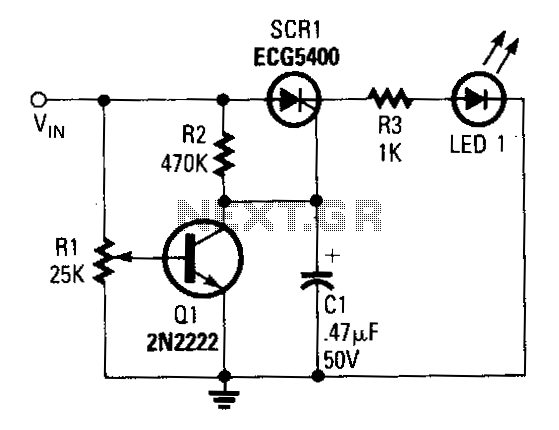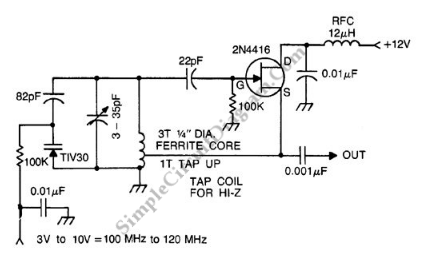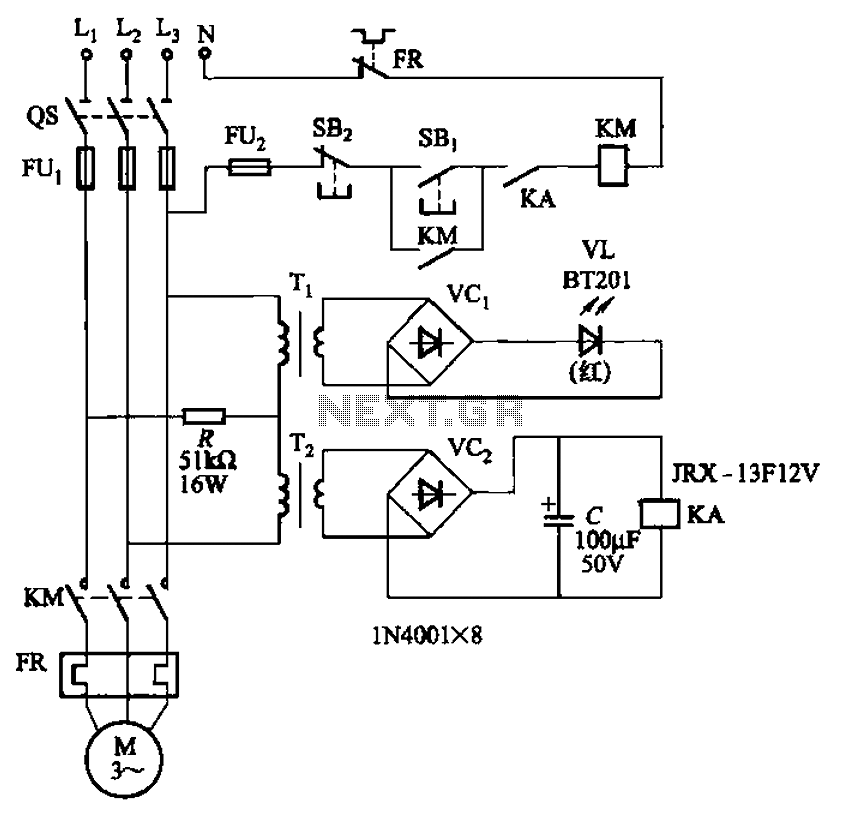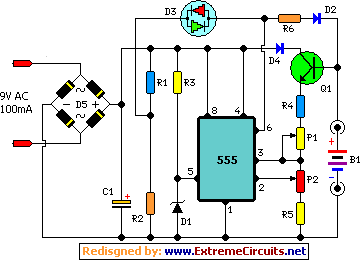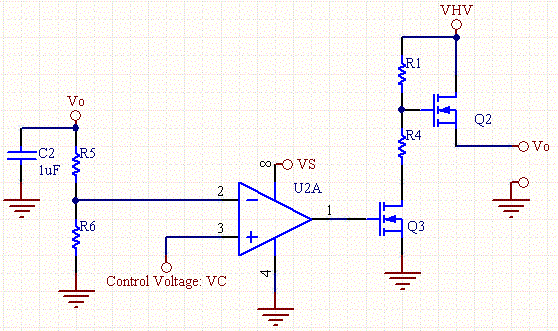
3 LED Car battery Indicator
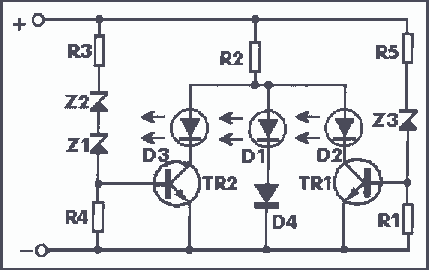
The operating principle of the circuit is very simple. The first LED D1 is placed in series with the resistor R2 and diode D4. An only be lit this LED indicates that the battery is overcharged. For this reason, LED D1 is red. If the voltage is greater than 12V, then netting R5 Z3 turns the transistor TR1, so the glows and LED D2 indicates that the battery of your car is okay and that is why color is green. Now, if the battery voltage exceeds 13.5 V in the same way it lights up and the third LED D3 in the middle of the transistor TR2. In cases this increase in voltage is detected by the panel R3 Z1 Z2. This means that your battery is overcharged.
Specifications:
Operating voltage: 9 - 14V DC
Current operation: 40 mA
Green LED: battery voltage 12 - 13.8 V
Red LED: over voltage 13.8 V
Amber LED: voltage below 12V
The circuit operates within a specified voltage range of 9 to 14 volts DC, making it suitable for monitoring standard automotive battery conditions. The primary components include three LEDs (D1, D2, and D3), resistors (R2, R3, and R5), diodes (D4, Z1, Z2, and Z3), and transistors (TR1 and TR2).
LED D1, colored red, serves as an indicator for under-voltage conditions, lighting up when the battery voltage falls below 12V. This is a critical alert for the user, indicating that the battery may require charging. The circuit achieves this by utilizing a resistor R2 in series with LED D1, ensuring proper current flow and limiting the current to safe levels.
When the battery voltage reaches or exceeds 12V, the circuit activates transistor TR1 via the combination of resistor R5 and zener diode Z3. This action allows for the illumination of LED D2, which is green, indicating that the battery is within an acceptable voltage range of 12 to 13.8V. This state confirms that the battery is functioning properly without any immediate concerns.
As the voltage continues to rise and surpasses the threshold of 13.5V, the circuit engages transistor TR2, which subsequently activates LED D3. This LED serves as a warning indicator for over-voltage conditions, alerting the user that the battery is overcharged and may require attention to prevent potential damage.
Overall, the circuit effectively monitors battery voltage levels and provides visual feedback through the use of colored LEDs, thereby enhancing the user's ability to maintain battery health and avoid overcharging scenarios. The inclusion of zener diodes ensures voltage regulation and stability, contributing to the circuit's reliability and performance in automotive applications.The operating principle of the circuit is very simple. The first Led D1 is placed in series with the resistor R2 and diode D4.An only be lit this LED indicates that the battery is ypofortismeni. For this reason Led D1 is red. If the voltage is greater than 12V, then netting R5 Z3 turns the transistor TR1, so the glows and Led D2 indicates that the battery of your car is okay and that is why color is green.
Now, if the battery voltage exceeds 13,5 V in the same way it lights up and the third LED D3 in the middle of the transistor TR2.Stin cases this increase in voltage is detected by the panel R3 Z1 Z2.Afto means that your battery is yperfortismeni. Specifications: Operating voltage: 9 - 14V DC operation: 40 mA Green LED: battery voltage 12 - 13,8 V Red LED: over voltage 13,8 V Amber LED: voltage below 12V 🔗 External reference
Specifications:
Operating voltage: 9 - 14V DC
Current operation: 40 mA
Green LED: battery voltage 12 - 13.8 V
Red LED: over voltage 13.8 V
Amber LED: voltage below 12V
The circuit operates within a specified voltage range of 9 to 14 volts DC, making it suitable for monitoring standard automotive battery conditions. The primary components include three LEDs (D1, D2, and D3), resistors (R2, R3, and R5), diodes (D4, Z1, Z2, and Z3), and transistors (TR1 and TR2).
LED D1, colored red, serves as an indicator for under-voltage conditions, lighting up when the battery voltage falls below 12V. This is a critical alert for the user, indicating that the battery may require charging. The circuit achieves this by utilizing a resistor R2 in series with LED D1, ensuring proper current flow and limiting the current to safe levels.
When the battery voltage reaches or exceeds 12V, the circuit activates transistor TR1 via the combination of resistor R5 and zener diode Z3. This action allows for the illumination of LED D2, which is green, indicating that the battery is within an acceptable voltage range of 12 to 13.8V. This state confirms that the battery is functioning properly without any immediate concerns.
As the voltage continues to rise and surpasses the threshold of 13.5V, the circuit engages transistor TR2, which subsequently activates LED D3. This LED serves as a warning indicator for over-voltage conditions, alerting the user that the battery is overcharged and may require attention to prevent potential damage.
Overall, the circuit effectively monitors battery voltage levels and provides visual feedback through the use of colored LEDs, thereby enhancing the user's ability to maintain battery health and avoid overcharging scenarios. The inclusion of zener diodes ensures voltage regulation and stability, contributing to the circuit's reliability and performance in automotive applications.The operating principle of the circuit is very simple. The first Led D1 is placed in series with the resistor R2 and diode D4.An only be lit this LED indicates that the battery is ypofortismeni. For this reason Led D1 is red. If the voltage is greater than 12V, then netting R5 Z3 turns the transistor TR1, so the glows and Led D2 indicates that the battery of your car is okay and that is why color is green.
Now, if the battery voltage exceeds 13,5 V in the same way it lights up and the third LED D3 in the middle of the transistor TR2.Stin cases this increase in voltage is detected by the panel R3 Z1 Z2.Afto means that your battery is yperfortismeni. Specifications: Operating voltage: 9 - 14V DC operation: 40 mA Green LED: battery voltage 12 - 13,8 V Red LED: over voltage 13,8 V Amber LED: voltage below 12V 🔗 External reference

